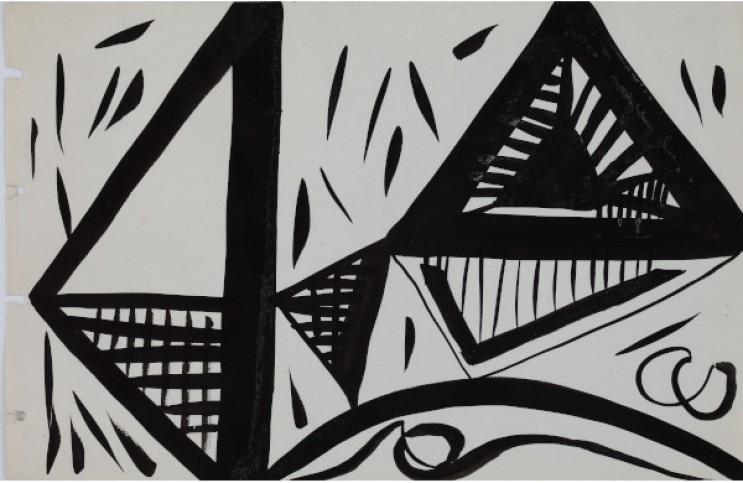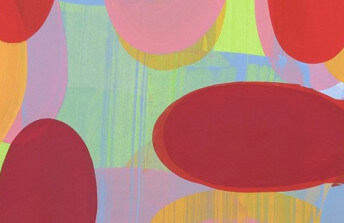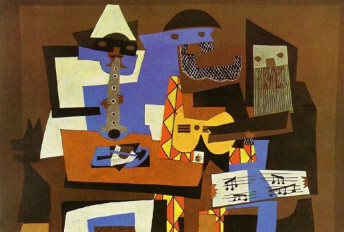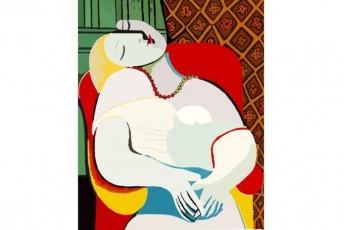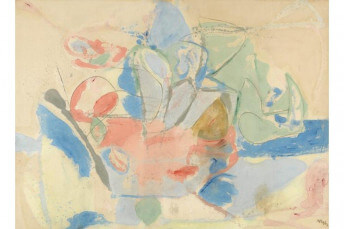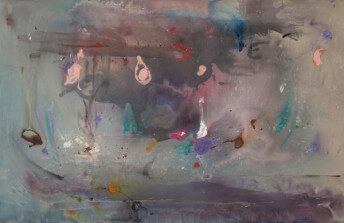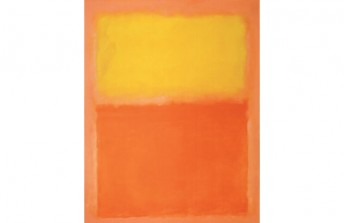The Fervent Abstraction of Olivier Debré
Apr 14, 2021
One of the most intriguing exhibitions coming to London this summer is Olivier Debré: Fervent Abstraction, opening in late June at The Estorick Collection. My interest in the exhibition is in part because of the artist, and in part because of where it is being held: the boutique museum is renowned for its collection of early 20th century, modern Italian—particularly Futurist—art. Olivier Debré (1920-1999) was not Italian, but French. He was also quite unlike the Futurists philosophically, particularly in respect to their ideas about war being a positive, cleaning force in society. Several signatories to the Futurist Manifesto enthusiastically fought on the side of the Fascists in World War I. Debré on the other hand was raised in the aftermath of that war, and himself joined the French resistance fighting against the Fascists in World War II. Nonetheless, there is some fascinating crossover between Debré and the early Italian Modernists when it comes to their interest in expressing the metaphysical in art. The Futurists made pioneering discoveries in their attempts to paint sensations such as speed and the experience of synesthesia. Debré made equivalently profound discoveries in his quest to use painting as a way to express emotion without using description. Debré was interested in the profound sense of communion that happens when we feel that someone else shares our exact emotions. He also realized the inadequacy of words when it comes to trying to explain to someone else how we feel. His paintings can be understood both as attempts to express an emotional state, and as attempts at creating spaces where emotional connections might be made and fostered. Rejecting the pretensions of high art in favor of more humanist gestures, he painted on the floor instead of on an easel. He also added humble materials like sand to his paint, and used everyday tools like brooms to apply his mediums. The diverse body of work he created has become synonymous with the term Lyrical Abstraction. It is the material manifestation of sensuousness and subjectivity—the painterly equivalent of poetry and music.
Signs and Symbols
One of the most often told stories about Debré is that Pablo Picasso came to his first big solo exhibition in Paris. After viewing the work, Picasso told Debré, then in his early 30s, “You already paint like an old man.” This enigmatic comment is evidently what set Debré on a path towards developing his signature abstract voice. Rather than copying the popular styles of the time, he began an exhaustive process of trying to discover exactly how it is that an artist can convey thoughts and feelings through abstract art. He started by analyzing how people most often convey their feelings to each other: through words. Written language, he realized, is the very embodiment of symbolic communication, as ideas are translated as lines on surfaces created by way of physical human gestures. This epiphany set him on a path towards creating his own gestural, linear symbology, which he could use to convey his feelings and facilitate emotional connections between viewers.
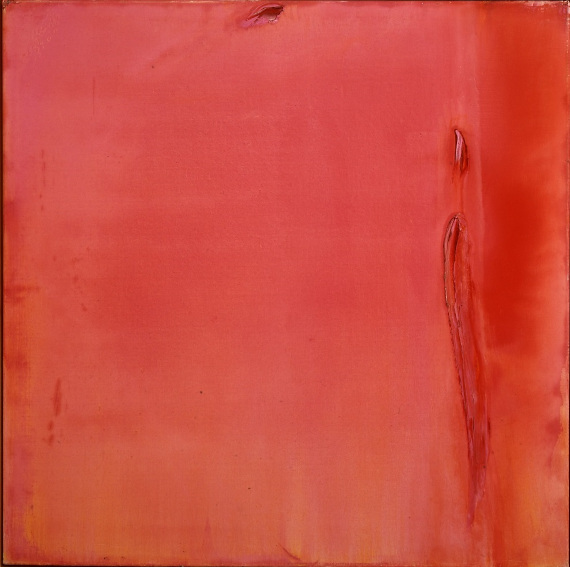
Olivier Debré - Monochrome rose rouge, trace rouge rose, 1984. Oil on canvas, 180 x 180 cm. Collection Galerie, Louis Carré & Cie, Paris
Up to that point, the most common emotions Debré had experienced had been loneliness and grief. In fact, his first connection to art came when he was just nine years old and his mother died, and his father and uncle encouraged him to draw and paint as a way of dealing with the loss. The unspeakable horrors he later witnessed while fighting against the Nazis repeatedly reminded him of the isolation and suffering that so often define the human condition. His breakthrough effort to express these terrible feelings came in the early 1950s, with a series of abstract paintings he called Signes-Personnages (Character Signs). Consisting mostly of vertical, linear, black forms on white backgrounds, the works resemble a hybrid of human figures and lettering. It was not solitary humans Debré was trying to show in these works—these are pictures of the essence of solitude itself.

Olivier Debré - Sans titre, c. 1990. Oil on canvas, 100 x 100 cm. Private collection
Reality is Painting Us
In addition to the long running Signes-Personnages series, Debré devoted many decades to his series of abstract landscape paintings, which he called Signes-Paysages (Landscape Signs). Defined by broad swaths of vibrant color, these paintings share a visual heritage with the work of Color Field artists like Helen Frankenthaler and Mark Rothko. Debré made these paintings to express the sensations he felt while interacting with the natural environment. However, he did not speak about this body of work in terms of him making paintings of the natural world, because he did not perceive reality as something that humans create. Instead, he perceived the human experience as something that is constantly being formed and reformed by a natural reality beyond our grasp. “There is a kind of over-lapping between the mental atmosphere and the real atmosphere,” he said. “We are always both in ourselves and outside ourselves. I paint in the emotion of a reality that generates me.”
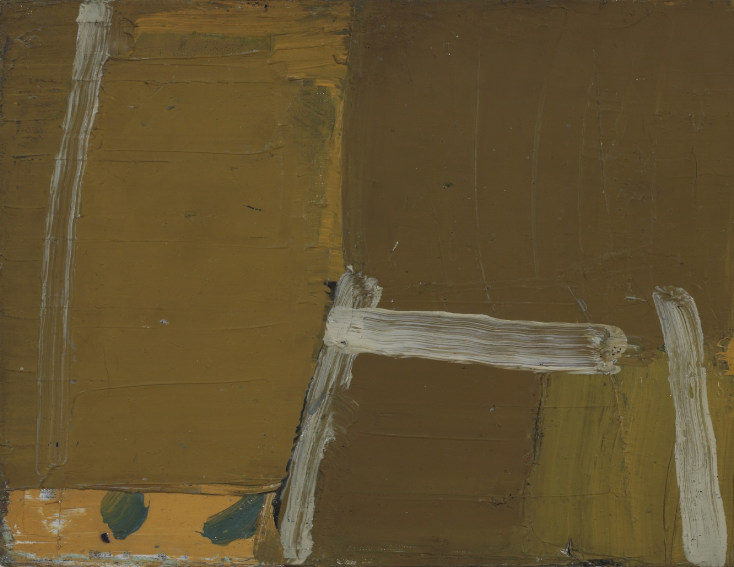
Olivier Debré - Sans titre, c. 1958. Oil on canvas, 27 x 35 cm. Private collection
In addition to the enormous body of paintings Debré created, he also made a name for himself in the world of monumental pubic works, creating numerous public sculptures as well as a collection of beloved theatrical curtains, including curtains for opera houses in London and Hong Kong. Whenever he reflected on his vast and diverse oeuvre, he called the essence of what he was looking for le signe du réel, or the sign of the real. Fervent abstraction is the name he came up with to convey the passion and immediacy of a gesture, a symbol and a feeling simultaneously coming into being.
Like Picasso in the early days of Cubism, Debré was on a quest to uncover a deeper realism beyond the world of artistic mimicry; a realism that captured the mystery and beauty of both the seen and unseen parts of life.
Olivier Debré: Fervent Abstraction will be on view 30 June through 12 September 2021 through at The Estorick Collection of Modern Italian Art in London.
Featured image: Olivier Debré - Sans titre, c. 1946. Indian ink on paper. 20.2 x 30.9 cm. Private collection
All images used for illustrative purposes only
By Phillip Barcio
